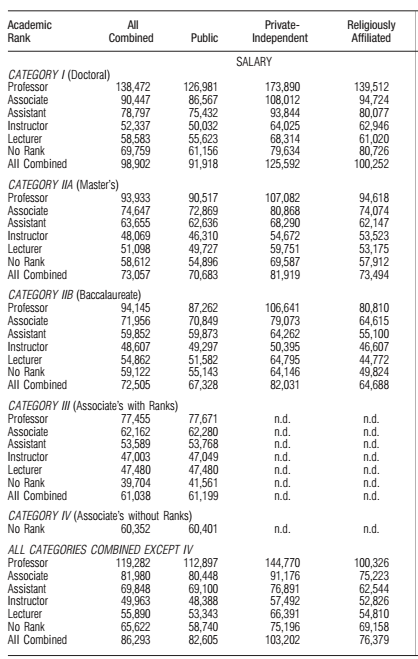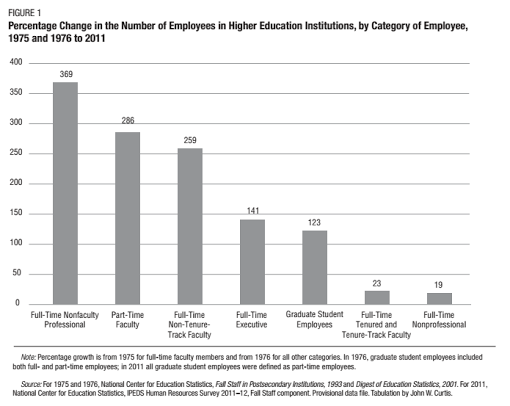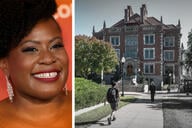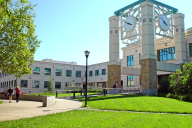You have /5 articles left.
Sign up for a free account or log in.
Full-time faculty member salaries are up 2.2 percent this year over last, outpacing the rate of inflation for the first time in five years. And faculty members who remained at the same institution earned pay bumps averaging 3.4 percent, according to a report out today from the American Association of University Professors. Although the report shows bigger salary gains for professors than any they've had in the last five years, it also makes clear that faculty pay remains below pre-recession levels and makes the case that higher education is continuing to prioritize spending on administration and athletics over instruction.
"Increasingly, institutions of higher education have lost their focus on the academic activities at the core of their mission,” the report says. “Spending on administrative overhead continues to draw funding away from academic programs, and the proliferation of new administrative and support positions has continued unabated in the two decades since ‘administrative bloat’ was brought into the higher education lexicon.”
Even more “troubling,” it says, “the pattern of substantial salary increases for a very few senior administrators […] continues while full-time faculty salaries stagnate; the overwhelming majority of our academic colleagues struggle to provide excellent instruction while mired in precarious contingent appointments; and staff colleagues hiring and salary freezes, benefits cuts and even layoffs.”
“Losing Focus: The Annual Report on the Economic Status of the Profession, 2013–14,” says that faculty salary increases are better this year than they have been for several years. Adjusted for inflation, however, the rise in average faculty salary exceeded the rise in the cost of living by just one percentage point, indicating a “continuation of the long period of stagnation in average full-time faculty salaries.” For continuing faculty members at the same institution, the average real increase after adjusting for inflation is slightly better, at 1.9 percent.
The AAUP study does not include part-time professors. As a result, while full-time, non-tenure-track faculty members are counted, the adjuncts who are not full-time -- many of whom face flat wages -- are not covered. So those faculty members who earn the least, and may have the least chances of earning a raise, aren't included.
The AAUP has institution by institution data available on its website and top 10 lists are included at the bottom of this article.
Breaking down those figures by institution type, as in years past, full-time faculty at private colleges and universities fared better than their colleagues at publics, with a 2.6 percent raise compared to a 1.7 percent raise, respectively. Faculty at public, doctorate-granting institutions fared worst. Full professors got the biggest raises over all (2.4 percent) and at private institutions (3 percent) but assistant professors got the biggest bump at public institutions, with a 2.4 percent raise. That’s compared to 2.1 percent bumps for associate professors; 2.2 percent bumps for full professors; and 2.3 percent bumps for instructors.
On average, full professors at public institutions earned $112,897, while their colleges at private institutions earned $144,770. Full professors at religiously affiliated colleges earned $100,326.
Associate professors at publics earned $80,448, while associate professors at privates earned $91,176, and those at religious institutions earned $75,223.
Assistant professors at public institutions made $69,100. Assistant professors at private institutions made $76,891 and they earned $62,544 at religiously affiliated institutions.
Lecturers earned $53,353; $66,391; and $54,810, respectively.

The report includes data from 3,725 institutions – 2,102 publics and 910 privates, and 713 religiously affiliated institutions. College and university data is supplemented with data from the National Center for Education Statistics, the College and University Professionals Association-Human Resources, the National Collegiate Athletic Association and other sources.
John Curtis, director of research and public policy for AAUP and one of the report's two authors, called the 2.2 percent pay increase “still quite low by historical standards.” At the same time, he said, there’s been significant growth in other areas of institutions’ spending – Curtis doesn’t like the word “budget,” which is more like a plan, he said.
He continued: “We wanted to look at what really happened, look at the data on actual expenditures.”
So if not on instruction, where did the money go?
‘Administrative bloat’
“Undetected, unprotested, and unchecked, the excessive growth of administrative expenditures has done a lot of damage to life and learning on our campuses. On each campus that suffers from this disease, and most apparently do, millions of dollars have been swallowed up."
If that part of the report sounds familiar that’s because it is. The words, written by Barbara Bergman, former president of the AAUP, come from the lead essay in a 1991 issue of AAUP’s journal, Academe, devoted to the topic of “Administrative Bloat.”
Although decades old, the sentiment still holds, the report says.
From about 1976 to 2011, full-time, non-professional employee ranks at colleges and universities grew 369 percent, while full-time, tenure and tenure-track ranks grew by just 23 percent.
Senior administrator positions grew at a slower rate than administrations over all, at 141 percent, but the rate represents “more than a doubling in the number of people at the top of the organizational hierarchy,” the report says.
It also notes that administrative titles have more than doubled since the late 1970s.
As positions have grown at a rate outpacing full-time faculty, so too have administrative salaries.
Since the late 1970s, “chief executive officers” private institutions, on average, have seen a close to 175 percent salary increase, while full professors have seen a 50 percent pay increase. CEOs at public institutions, on average, have seen a 75 percent pay increase while full professor salaries have grown less than a quarter.
The report doesn’t focus too closely part-time faculty trends, which were central in last year’s Annual Report. But it notes that the relative stagnation of tenure-track positions have been coupled with explosive growth in part-time and full-time, non-tenure-track faculty positions: 286 percent and 259 percent, respectively.

The number of graduate school employees also expanded, by 123 percent.
Curtis called administrative spending trends “discouraging,” particularly as colleges and universities nationwide have faced salary freezes or department closures, or both, in recent years.
He said that there’s “a grain of truth” to the argument that the proliferation of administrative positions reflects regulatory and accountability mechanism growth over the same period, but that there are still more administrators than there are programs to administer.
“It is the case, yes, that there are additional regulations, and there are increased calls for accountability and measuring learning outcomes for various reasons,” he said. “But even with those factors, it doesn’t support the rapid rise in administrative positions and it certainly doesn’t support the inequality in salaries that we’re experiencing.”
Debunking Idea of ‘Revenue-Generating’ Sports
In addition to top administrator salaries and positions, the AAUP report also argues that funds are being diverted from the core mission of instruction to athletics.
“It has been argued that athletic spending doesn’t take funding away from academics because ‘revenue-generating’ sports such as football and men’s basketball bring in sufficient funds to finance themselves along with other sports teams,” the report says. “The evidence, however, shows this assertion to be untrue.”
Of more than 1,000 college and university members of the NCAA, just 23 institutions reported that their athletic programs ran a surplus, according to the report. All were Division I-A. And while even unprofitable programs can attract external funding, institutional subsidies are biggest in the lower divisions – 82 percent of DI-AAA programs in 2012.
Between 2004 and 2011, per-student spending on instruction declined at community colleges and increased by 1 percent (adjusted for inflation) at public four-year institutions and 5 percent at private, four-year institutions. That’s compared to per-athlete spending during the same period, at 35, 25 and 29 percent, respectively, the report says.

Saranna Thornton, professor of economics and head coach of the men’s rugby team at Hampden-Sydney College, serves as AAUP’s chair of its Committee on the Economic Status of the Profession and co-wrote the report with Curtis.
“Everyone knows that spending in athletics (per student/adjusted for inflation) has increased even more rapidly than tuition,” she said via email, highlighting the finding that just under two dozen sports programs in any division are “profit centers that pay for themselves.”
She continued: “In a time when the U.S. president and Congress are worried about the rising costs of higher education and the rising debt loads of graduating students -- why aren't parents and students and legislators screaming about this?”
‘Doesn’t Have to Be This Way’
Despite the historical trends described in the report, the authors argue it “doesn’t have to be this way.”
“Those of us who teach and work with students community organizations on a daily basis know that higher education still has the amazing power to transform student lives and help create solutions to the myriad challenges our society faces,” it says. “This report provides one resources that we hope will be useful in bringing some [questionable spending] practices to light.”
Gary Rhoades, professor and director of the Center for the Study of Higher Education at the University of Arizona and former general secretary of AAUP, and a frequent critic of higher education spending priorities, agreed with the premise of the AAUP report and said it “makes good sense to feature ‘misplaced priorities’ in the allocation of monies at colleges and universities nationally.”
He said the report told a “consistent story,” and “a story that needs to be told repeatedly, to pressure institutions to shift their priorities to the core academic missions.”
Rhoades said that as the White House considers how it might rate institutions in a proposed federal plan, “Would it not make sense to make percentage of institutional expenditures spent on instruction a metric in that rating system, with an incentive to move the needle back over time towards investing in instruction?”
NCAA spokeswoman Stacey Osburn said via email that AAUP’s find that just 23 programs were profitable was accurate. But she said that sports are about more than profit.
“The NCAA and its member schools support learning through sports by integrating athletics and higher education to enrich the college experience of student-athletes,” Osburn said. “We also firmly believe that college athletics enriches the educational experience for student-athletes. By competing in college sports, student-athletes learn important skills, like leadership, time management and how to effectively work with others toward a common goal.”
The National Association of College and University Business Offers declined to comment on the administrative portion of the AAUP report.
Individual Institutions
Many academics turn to the AAUP survey to see which institutions pay the most, and the tables that follow list institutions that are at the top of various categories. But many caveats are in order. The AAUP data do not take into account wide variations in cost of living. Many of the institutions high on these lists are located in large metropolitan areas, and it is likely that many professors at institutions off these lists (but located in small college towns) may be more easily able to afford a nice home, living in the best local school district, and so forth.
Further, many studies have found wide variation in faculty salaries within individual institutions. So engineering, law and business professors (among others) earn well above these averages at many institutions, while those in the humanities may earn far less.
This year's top 10 list for private research universities (the best paying category by far) is almost identical in order to last year's -- with Columbia University in first place. The one change is that Massachusetts Institute of Technology edged out rival California Institute of Technology for the #10 spot. For the rest, the numbers are up a bit, but the order is the same.
Top Private Universities for Faculty Salaries for Full Professors, 2013-14
| University | Average Salary |
| 1. Columbia University | $215,500 |
| 2. Stanford University | $215,200 |
| 3. University of Chicago | $210,700 |
| 4. Harvard University | $207,100 |
| 5. Princeton University | $206,200 |
| 6. New York University | $195,700 |
| 7. University of Pennsylvania | $192,300 |
| 8. Yale University | $192,200 |
| 9. Duke University | $186,400 |
| 10. Massachusetts Institute of Technology | $185,900 |
As has been the case in previous years, the top institution for public pay would not make the top 10 for private pay. The University of California at Los Angeles tops this list, as it did last year. Two other University of California campuses (Berkeley and San Diego) also make the top 10 list.
On the full data tables on the AAUP website, it would appear that Rutgers University at New Brunswick should appear on this list. But AAUP officials believe that the Rutgers figures are incorrect, but they have not yet received information to make a full correction, so that institution is not the table that follows.
Top Public Universities for Faculty Salaries for Full Professors, 2013-14
| University | Average Salary |
| 1. University of California at Los Angeles | $173,900 |
| 2. New Jersey Institute of Technology | $173,100 |
| 3. Rutgers University at Newark | $166,800 |
| 4. University of California at Berkeley | $165,400 |
| 5. University of Michigan at Ann Arbor | $156,900 |
| 6. University of Virginia | $150,800 |
| 7. University of Texas at Dallas | $149,300 |
| 8. University of California at San Diego | $147,900 |
| 9. University of Maryland at Baltimore | $147,400 |
| 10. University of North Carolina at Chapel Hill | $146,700 |
The top liberal arts colleges for pay for full professors are very similar to the lists in recent years, with the top four unchanged in their ranks.
Top Liberal Arts Colleges for Faculty Salaries for Full Professors, 2013-14
| College | Average Salary |
| 1. Wellesley College | $154,100 |
| 2. Claremont McKenna College | $152,100 |
| 3. Barnard College | $147,100 |
| 4. Pomona College | $145,900 |
| 5. Swarthmore College | $140,700 |
| 6. (tie) Amherst College | $140,000 |
| 6. (tie) Williams College | $140,000 |
| 8. Harvey Mudd College | $139,300 |
| 9. Colgate University | $138,100 |
| 10. Wesleyan University | $136,300 |
This year, the data show 19 colleges and universities where the average salary for an assistant professor tops $100,000. That's up from 11 institutions last year, and 9 the year before.
Colleges With Six-Figure Salaries for Assistant Professors, 2013-14
| University | Average Salary |
| 1. University of Pennsylvania | $118,000 |
| 2. Stanford University | $117,500 |
| 3. California Institute of Technology | $116,200 |
| 4. Harvard University | $114,400 |
| 5. Massachusetts Institute of Technology | $111,100 |
| 6. Columbia University | $110,900 |
| 7. New York University | $110,100 |
| 8. Bryant University | $108,700 |
| 9. Rutgers University at Newark | $106,800 |
| 10. University of Chicago | $105,600 |
| 11. Naval Postgraduate School | $105,200 |
| 12. Menlo College | $104,900 |
| 13. (tie) Babson College | $104,400 |
| 13. (tie) Carnegie Mellon University | $104,400 |
| 15. Duke University | $103,500 |
| 16. Northwestern University | $102,700 |
| 17. Princeton University | $101,700 |
| 18. University of Texas at Dallas | $101,600 |
| 19. Georgetown University | $101,200 |





